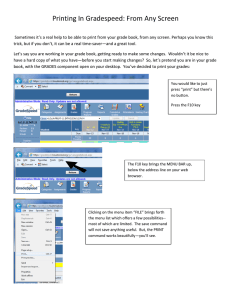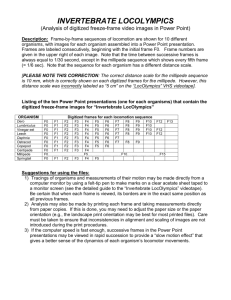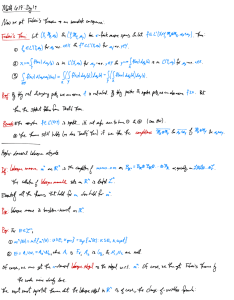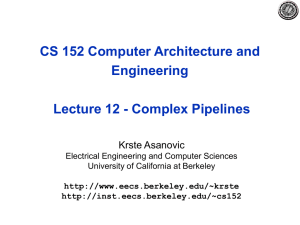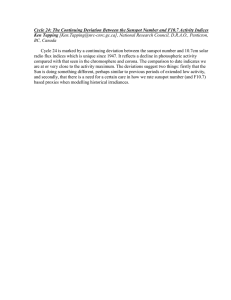ppt (Office 98)
advertisement
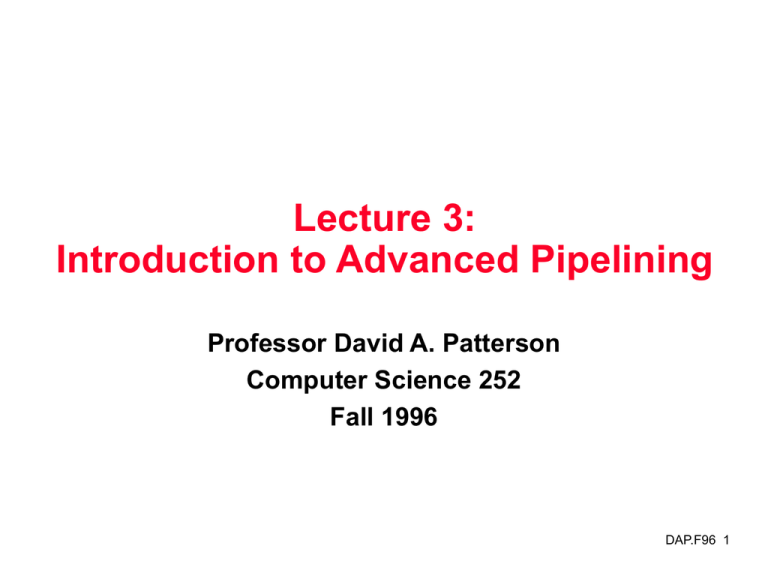
Lecture 3:
Introduction to Advanced Pipelining
Professor David A. Patterson
Computer Science 252
Fall 1996
DAP.F96 1
Review: Evaluating Branch
Alternatives
• Two part solution:
– Determine branch taken or not sooner, AND
– Compute taken branch address earlier
Pipeline speedup =
Pipeline depth
1 +Branch frequency Branch penalty
Scheduling
Branch
scheme
penalty
Stall pipeline
3
Predict taken
1
Predict not taken
1
Delayed branch
0.5
CPI
1.42
1.14
1.09
1.07
speedup v.
unpipelined
3.5
4.4
4.5
4.6
speedup v.
stall
1.0
1.26
1.29
1.31
DAP.F96 2
Review: Evaluating Branch
Prediction
• Two strategies
10000
1000
100
10
Profile-based
tomcatv
swm256
ora
mdljsp2
hydro2d
gcc
espresso
doduc
compress
1
alvinn
• “Instructions between
mispredicted
branches” a better
metric than
misprediction
100000
Instructions per mispredicted branch
– Backward branch predict
taken, forward branch not
taken
– Profile-based prediction:
record branch behavior,
predict branch based on
prior run
Direction-based
DAP.F96 3
Review: Summary of Pipelining Basics
• Hazards limit performance
– Structural: need more HW resources
– Data: need forwarding, compiler scheduling
– Control: early evaluation & PC, delayed branch, prediction
• Increasing length of pipe increases impact of hazards;
pipelining helps instruction bandwidth, not latency
• Interrupts, Instruction Set, FP makes pipelining harder
• Compilers reduce cost of data and control hazards
– Load delay slots
– Branch delay slots
– Branch prediction
• Today: Longer pipelines (R4000) => Better branch
prediction, more instruction parallelism?
DAP.F96 4
Case Study: MIPS R4000
(200 MHz)
• 8 Stage Pipeline:
– IF–first half of fetching of instruction; PC selection happens here
as well as initiation of instruction cache access.
– IS–second half of access to instruction cache.
– RF–instruction decode and register fetch, hazard checking and
also instruction cache hit detection.
– EX–execution, which includes effective address calculation, ALU
operation, and branch target computation and condition
evaluation.
– DF–data fetch, first half of access to data cache.
– DS–second half of access to data cache.
– TC–tag check, determine whether the data cache access hit.
– WB–write back for loads and register-register operations.
• 8 Stages: What is impact on Load delay? Branch
DAP.F96 5
delay? Why?
Case Study: MIPS R4000
IF
IS
IF
RF
IS
IF
EX
RF
IS
IF
DF
EX
RF
IS
IF
DS
DF
EX
RF
IS
IF
TC
DS
DF
EX
RF
IS
IF
WB
TC
DS
DF
EX
RF
IS
IF
IF
THREE Cycle
Branch Latency
(conditions evaluated
during EX phase)
IS
IF
RF
IS
IF
EX
RF
IS
IF
DF
EX
RF
IS
IF
DS
DF
EX
RF
IS
IF
TC
DS
DF
EX
RF
IS
IF
WB
TC
DS
DF
EX
RF
IS
IF
TWO Cycle
Load Latency
Delay slot plus two stalls
Branch likely cancels delay slot if not taken
DAP.F96 6
MIPS R4000 Floating Point
• FP Adder, FP Multiplier, FP Divider
• Last step of FP Multiplier/Divider uses FP Adder HW
• 8 kinds of stages in FP units:
Stage
A
D
E
M
N
R
S
U
Functional unit
FP adder
FP divider
FP multiplier
FP multiplier
FP multiplier
FP adder
FP adder
Description
Mantissa ADD stage
Divide pipeline stage
Exception test stage
First stage of multiplier
Second stage of multiplier
Rounding stage
Operand shift stage
Unpack FP numbers
DAP.F96 7
MIPS FP Pipe Stages
FP Instr
Add, Subtract
Multiply
Divide
Square root
Negate
Absolute value
FP compare
Stages:
M
N
R
S
U
1
U
U
U
U
U
U
U
2
S+A
E+M
A
E
S
S
A
3
4
A+R R+S
M
M
R
D28
(A+R)108
7
8
…
5
6
M
…
…
N
N+A R
D+A D+R, D+R, D+A, D+R, A, R
A
R
R
First stage of multiplier
Second stage of multiplier
Rounding stage
Operand shift stage
Unpack FP numbers
A
D
E
Mantissa ADD stage
Divide pipeline stage
Exception test stage
DAP.F96 8
R4000 Performance
Base
Load stalls
Branch stalls
FP result stalls
tomcatv
su2cor
spice2g6
ora
nasa7
doduc
li
gcc
espresso
eqntott
• Not ideal CPI of 1:
– Load stalls (1 or 2 clock cycles)
– Branch stalls (2 cycles + unfilled slots)
– FP result stalls: RAW data hazard (latency)
– FP structural stalls: Not enough FP hardware (parallelism)
4.5
4
3.5
3
2.5
2
1.5
1
0.5
0
FP structural
stalls
DAP.F96 9
Advanced Pipelining and
Instruction Level Parallelism (ILP)
• ILP: Overlap execution of unrelated instructions
• gcc 17% control transfer
– 5 instructions + 1 branch
– Beyond single block to get more instruction level parallelism
• Loop level parallelism one opportunity, SW and HW
• Do examples and then explain nomenclature
• DLX Floating Point as example
– Measurements suggests R4000 performance FP execution has room
for improvement
DAP.F96 10
FP Loop: Where are the Hazards?
Loop:
LD
ADDD
SD
SUBI
BNEZ
NOP
F0,0(R1)
F4,F0,F2
0(R1),F4
R1,R1,8
R1,Loop
Instruction
producing result
FP ALU op
FP ALU op
Load double
Load double
Integer op
•
;F0=vector element
;add scalar from F2
;store result
;decrement pointer 8B (DW)
;branch R1!=zero
;delayed branch slot
Instruction
using result
Another FP ALU op
Store double
FP ALU op
Store double
Integer op
Where are the stalls?
Latency in
clock cycles
3
2
1
0
0
DAP.F96 11
FP Loop Showing Stalls
1 Loop: LD
2
stall
3
ADDD
4
stall
5
stall
6
SD
7
SUBI
8
BNEZ
9
stall
Instruction
producing result
FP ALU op
FP ALU op
Load double
F0,0(R1)
;F0=vector element
F4,F0,F2
;add scalar in F2
0(R1),F4
R1,R1,8
R1,Loop
;store result
;decrement pointer 8B (DW)
;branch R1!=zero
;delayed branch slot
Instruction
using result
Another FP ALU op
Store double
FP ALU op
Latency in
clock cycles
3
2
1
• 9 clocks: Rewrite code to minimize stalls?
DAP.F96 13
Revised FP Loop Minimizing Stalls
1 Loop: LD
2
stall
3
ADDD
4
SUBI
5
BNEZ
6
SD
F0,0(R1)
F4,F0,F2
R1,R1,8
R1,Loop
8(R1),F4
;delayed branch
;altered when move past SUBI
Swap BNEZ and SD by changing address of SD
Instruction
producing result
FP ALU op
FP ALU op
Load double
Instruction
using result
Another FP ALU op
Store double
FP ALU op
Latency in
clock cycles
3
2
1
6 clocks: Unroll loop 4 times code to make faster? DAP.F96 14
Unroll Loop Four Times
(straightforward way)
1 Loop: LD
2
ADDD
3
SD
4
LD
5
ADDD
6
SD
7
LD
8
ADDD
9
SD
10
LD
11
ADDD
12
SD
13
SUBI
14
BNEZ
15
NOP
F0,0(R1)
F4,F0,F2
0(R1),F4
F6,-8(R1)
F8,F6,F2
-8(R1),F8
F10,-16(R1)
F12,F10,F2
-16(R1),F12
F14,-24(R1)
F16,F14,F2
-24(R1),F16
R1,R1,#32
R1,LOOP
;drop SUBI &
Rewrite loop to
BNEZ minimize stalls?
;drop SUBI & BNEZ
;drop SUBI & BNEZ
;alter to 4*8
15 + 4 x (1+2) = 27 clock cycles, or 6.8 per iteration
DAP.F96 15
Assumes R1 is multiple of 4
Unrolled Loop That Minimizes Stalls
1 Loop:
2
3
4
5
6
7
8
9
10
11
12
13
14
LD
LD
LD
LD
ADDD
ADDD
ADDD
ADDD
SD
SD
SD
SUBI
BNEZ
SD
F0,0(R1)
F6,-8(R1)
F10,-16(R1)
F14,-24(R1)
F4,F0,F2
F8,F6,F2
F12,F10,F2
F16,F14,F2
0(R1),F4
-8(R1),F8
-16(R1),F12
R1,R1,#32
R1,LOOP
8(R1),F16
• What assumptions
made when moved
code?
– OK to move store past
SUBI even though changes
register
– OK to move loads before
stores: get right data?
– When is it safe for
compiler to do such
changes?
; 8-32 = -24
14 clock cycles, or 3.5 per iteration
When safe to move instructions?
DAP.F96 16
Compiler Perspectives on Code
Movement
• Definitions: compiler concerned about dependencies
in program, whether or not a HW hazard depends on
a given pipeline
• Try to schedule to avoid hazards
• (True) Data dependencies (RAW if a hazard for HW)
– Instruction i produces a result used by instruction j, or
– Instruction j is data dependent on instruction k, and instruction k
is data dependent on instruction i.
• If depedent, can’t execute in parallel
• Easy to determine for registers (fixed names)
• Hard for memory:
– Does 100(R4) = 20(R6)?
– From different loop iterations, does 20(R6) = 20(R6)?
DAP.F96 17
Where are the data dependencies?
1 Loop: LD
2
ADDD
3
SUBI
4
BNEZ
5
SD
F0,0(R1)
F4,F0,F2
R1,R1,8
R1,Loop
8(R1),F4
;delayed branch
;altered when move past SUBI
DAP.F96 18
Compiler Perspectives on Code
Movement
• Another kind of dependence called name dependence:
two instructions use same name (register or memory
location) but don’t exchange data
• Antidependence (WAR if a hazard for HW)
– Instruction j writes a register or memory location that instruction i
reads from and instruction i is executed first
• Output dependence (WAW if a hazard for HW)
– Instruction i and instruction j write the same register or memory
location; ordering between instructions must be preserved.
DAP.F96 19
Where are the name
dependencies?
1 Loop: LD
2
ADDD
3
SD
4
LD
2
ADDD
3
SD
7
LD
8
ADDD
9
SD
10
LD
11
ADDD
12
SD
13
SUBI
14
BNEZ
15
NOP
F0,0(R1)
F4,F0,F2
0(R1),F4
F0,-8(R1)
F4,F0,F2
-8(R1),F4
F0,-16(R1)
F4,F0,F2
-16(R1),F4
F0,-24(R1)
F4,F0,F2
-24(R1),F4
R1,R1,#32
R1,LOOP
;drop SUBI & BNEZ
;drop SUBI & BNEZ
;drop SUBI & BNEZ
;alter to 4*8
How can remove them?
DAP.F96 20
Compiler Perspectives on Code
Movement
• Again Name Dependenceis are Hard for Memory
Accesses
– Does 100(R4) = 20(R6)?
– From different loop iterations, does 20(R6) = 20(R6)?
• Our example required compiler to know that if R1
doesn’t change then:
0(R1) ≠ -8(R1) ≠ -16(R1) ≠ -24(R1)
There were no dependencies between some loads and
stores so they could be moved by each other
DAP.F96 22
Compiler Perspectives on Code
Movement
• Final kind of dependence called control dependence
• Example
if p1 {S1;};
if p2 {S2;};
S1 is control dependent on p1 and S2 is control
dependent on p2 but not on p1.
DAP.F96 23
Compiler Perspectives on Code
Movement
• Two (obvious) constraints on control dependences:
– An instruction that is control dependent on a branch cannot be moved
before the branch so that its execution is no longer controlled by the
branch.
– An instruction that is not control dependent on a branch cannot be
moved to after the branch so that its execution is controlled by the
branch.
• Control dependencies relaxed to get parallelism; get
same effect if preserve order of exceptions (address in
register checked by branch before use) and data flow
(value in register depends on branch)
DAP.F96 24
Where are the control
dependencies?
1 Loop: LD
2
ADDD
3
SD
4
SUBI
5
BEQZ
6
LD
7
ADDD
8
SD
9
SUBI
10
BEQZ
11
LD
12
ADDD
13
SD
14
SUBI
15
BEQZ
....
F0,0(R1)
F4,F0,F2
0(R1),F4
R1,R1,8
R1,exit
F0,0(R1)
F4,F0,F2
0(R1),F4
R1,R1,8
R1,exit
F0,0(R1)
F4,F0,F2
0(R1),F4
R1,R1,8
R1,exit
DAP.F96 25
When Safe to Unroll Loop?
• Example: Where are data dependencies?
(A,B,C distinct & nonoverlapping)
for (i=1; i<=100; i=i+1) {
A[i+1] = A[i] + C[i];
/* S1 */
B[i+1] = B[i] + A[i+1];} /* S2 */
1. S2 uses the value, A[i+1], computed by S1 in the same iteration.
2. S1 uses a value computed by S1 in an earlier iteration, since
iteration i computes A[i+1] which is read in iteration i+1. The same
is true of S2 for B[i] and B[i+1].
This is a “loop-carried dependence”: between iterations
• Implies that iterations are dependent, and can’t be
executed in parallel
• Not the case for our prior example; each iteration was
distinct
DAP.F96 26
HW Schemes: Instruction Parallelism
• Why in HW at run time?
– Works when can’t know real dependence at compile time
– Compiler simpler
– Code for one machine runs well on another
• Key idea: Allow instructions behind stall to proceed
DIVD
ADDD
SUBD
F0,F2,F4
F10,F0,F8
F12,F8,F14
– Enables out-of-order execution => out-of-order completion
– ID stage checked both for structuralScoreboard dates to CDC 6600
in 1963
DAP.F96 27
HW Schemes: Instruction Parallelism
• Out-of-order execution divides ID stage:
1. Issue—decode instructions, check for structural hazards
2. Read operands—wait until no data hazards, then read operands
• Scoreboards allow instruction to execute whenever
1 & 2 hold, not waiting for prior instructions
• CDC 6600: In order issue, out of order execution, out
of order commit ( also called completion)
DAP.F96 28
Scoreboard Implications
• Out-of-order completion => WAR, WAW hazards?
• Solutions for WAR
– Queue both the operation and copies of its operands
– Read registers only during Read Operands stage
• For WAW, must detect hazard: stall until other
completes
• Need to have multiple instructions in execution
phase => multiple execution units or pipelined
execution units
• Scoreboard keeps track of dependencies, state or
operations
• Scoreboard replaces ID, EX, WB with 4 stages DAP.F96 29
Four Stages of Scoreboard Control
1. Issue—decode instructions & check for
structural hazards (ID1)
If a functional unit for the instruction is free and no other
active instruction has the same destination register (WAW),
the scoreboard issues the instruction to the functional unit
and updates its internal data structure. If a structural or
WAW hazard exists, then the instruction issue stalls, and no
further instructions will issue until these hazards are cleared.
2. Read operands—wait until no data hazards, then
read operands (ID2)
A source operand is available if no earlier issued active
instruction is going to write it, or if the register containing
the operand is being written by a currently active functional
unit. When the source operands are available, the
scoreboard tells the functional unit to proceed to read the
operands from the registers and begin execution. The
scoreboard resolves RAW hazards dynamically in this step,
and instructions may be sent into execution out of order. DAP.F96
30
Four Stages of Scoreboard Control
3. Execution—operate on operands (EX)
The functional unit begins execution upon receiving
operands. When the result is ready, it notifies the scoreboard
that it has completed execution.
4. Write result—finish execution (WB)
Once the scoreboard is aware that the functional unit has
completed execution, the scoreboard checks for WAR
hazards. If none, it writes results. If WAR, then it stalls the
instruction.
Example:
DIVD
F0,F2,F4
ADDD F10,F0,F8
SUBD F8,F8,F14
CDC 6600 scoreboard would stall SUBD until ADDD reads
operands
DAP.F96 31
Three Parts of the Scoreboard
1. Instruction status—which of 4 steps the instruction is in
2. Functional unit status—Indicates the state of the
functional unit (FU). 9 fields for each functional unit
Busy—Indicates whether the unit is busy or not
Op—Operation to perform in the unit (e.g., + or –)
Fi—Destination register
Fj, Fk—Source-register numbers
Qj, Qk—Functional units producing source registers Fj, Fk
Rj, Rk—Flags indicating when Fj, Fk are ready
3. Register result status—Indicates which functional unit
will write each register, if one exists. Blank when no
pending instructions will write that register
DAP.F96 32
Detailed Scoreboard Pipeline
Control
Instruction
status
Wait until
Bookkeeping
Issue
Not busy (FU)
and not result(D)
Busy(FU) yes; Op(FU) op;
Fi(FU) `D’; Fj(FU) `S1’;
Fk(FU) `S2’; Qj Result(‘S1’);
Qk Result(`S2’); Rj not Qj;
Rk not Qk; Result(‘D’) FU;
Read
operands
Rj and Rk
Rj No; Rk No
Execution
complete
Functional unit
done
Write result
f((Fj( f )≠Fi(FU)
f(if Qj(f)=FU then Rj(f) Yes);
or Rj( f )=No) &
f(if Qk(f)=FU then Rj(f) Yes);
(Fk( f ) ≠Fi(FU) or
Result(Fi(FU)) 0; Busy(FU) No
Rk( f )=No))
DAP.F96 33
Scoreboard Example
Instruction status
Instruction
j
k
LD
F6
34+ R2
LD
F2
45+ R3
MULTDF0
F2 F4
SUBD F8
F6 F2
DIVD F10 F0 F6
ADDD F6
F8 F2
Functional unit status
Time Name
Integer
Mult1
Mult2
Add
Divide
Register result status
Clock
Issue
Read Execution
Write
operandscompleteResult
Busy
No
No
No
No
No
Op
dest
Fi
F0
F2
F4
S1
Fj
S2
Fk
FU for j FU for k Fj?
Qj
Qk
Rj
Fk?
Rk
F6
F8
F10
F30
F12
...
FU
DAP.F96 34
5 minute Class Break
• 80 minutes straight is too long for me to
lecture (12:40:00 – 2:00:00):
–
–
–
–
–
–
–
≈ 1 minute:
≈ 20 minute
≈ 3 minutes:
≈ 25 minutes:
5 minutes:
≈25 minutes:
≈1 minute:
review last time & motivate this lecture
lecture
discuss class manangement
lecture
break
lecture
summary of today’s important topics
DAP.F96 35
Scoreboard Example Cycle 1
Instruction status
Instruction
j
k
LD
F6 34+ R2
LD
F2 45+ R3
MULTDF0 F2 F4
SUBD F8 F6 F2
DIVD F10 F0 F6
ADDD F6 F8 F2
Functional unit status
Time Name
Integer
Mult1
Mult2
Add
Divide
Register result status
Clock
1
FU
Issue
1
Read
Execution
W rite
operandscompleteResult
Busy
Yes
No
No
No
No
Op
Load
dest
Fi
F6
F0
F2
F4
S1
Fj
S2
Fk
R2
FU for j FU for k Fj?
Qj
Qk
Rj
F6 F8 F10
F12
...
Fk?
Rk
Yes
F30
Integer
DAP.F96 36
Scoreboard Example Cycle 2
Instruction status
Instruction
j
k
LD
F6 34+ R2
LD
F2 45+ R3
MULTDF0 F2 F4
SUBD F8 F6 F2
DIVD F10 F0 F6
ADDD F6 F8 F2
Functional unit status
Time Name
Integer
Mult1
Mult2
Add
Divide
Register result status
Read
Execution
W rite
Issue operandscompleteResult
1
2
Clock
F0
2
Busy Op
Yes Load
No
No
No
No
FU
• Issue 2nd LD?
F2
dest
Fi
F6
S1
Fj
S2
Fk
R2
FU for j FU for k Fj?
Qj
Qk
Rj
F4
F6 F8 F10
F12
...
Fk?
Rk
Yes
F30
Integer
DAP.F96 37
Scoreboard Example Cycle 3
Instruction status
Instruction
j
k
LD
F6 34+ R2
LD
F2 45+ R3
MULTDF0 F2 F4
SUBD F8 F6 F2
DIVD F10 F0 F6
ADDD F6 F8 F2
Functional unit status
Time Name
Integer
Mult1
Mult2
Add
Divide
Register result status
Read
Execution
W rite
Issue operandscompleteResult
1
2
3
Clock
F0
3
•
FU
Issue MULT?
Busy Op
Yes Load
No
No
No
No
F2
dest
Fi
F6
S1
Fj
S2
Fk
R2
FU for j FU for k Fj?
Qj
Qk
Rj
F4
F6 F8 F10
F12
...
Fk?
Rk
Yes
F30
Integer
DAP.F96 38
Scoreboard Example Cycle 4
Instruction status
Instruction
j
k
LD
F6 34+ R2
LD
F2 45+ R3
MULTDF0 F2 F4
SUBD F8 F6 F2
DIVD F10 F0 F6
ADDD F6 F8 F2
Functional unit status
Time Name
Integer
Mult1
Mult2
Add
Divide
Register result status
Read
Execution
W rite
Issue operandscompleteResult
1
2
3
4
Clock
F0
4
FU
Busy Op
Yes Load
No
No
No
No
F2
dest
Fi
F6
S1
Fj
S2
Fk
R2
FU for j FU for k Fj?
Qj
Qk
Rj
F4
F6 F8 F10
F12
...
Fk?
Rk
Yes
F30
Integer
DAP.F96 39
Scoreboard Example Cycle 5
Instruction status
Instruction
j
k
LD
F6 34+ R2
LD
F2 45+ R3
MULTDF0 F2 F4
SUBD F8 F6 F2
DIVD F10 F0 F6
ADDD F6 F8 F2
Functional unit status
Time Name
Integer
Mult1
Mult2
Add
Divide
Register result status
Read
Execution
W rite
Issue operandscompleteResult
1
2
3
4
5
Clock
F0
5
FU
Busy Op
Yes Load
No
No
No
No
F2
dest
Fi
F2
S1
Fj
S2
Fk
R3
FU for j FU for k Fj?
Qj
Qk
Rj
F4
F6 F8 F10
F12
...
Fk?
Rk
Yes
F30
Integer
DAP.F96 40
Scoreboard Example Cycle 6
Instruction status
Instruction
j
k
LD
F6 34+ R2
LD
F2 45+ R3
MULTDF0 F2 F4
SUBD F8 F6 F2
DIVD F10 F0 F6
ADDD F6 F8 F2
Functional unit status
Time Name
Integer
Mult1
Mult2
Add
Divide
Register result status
Read
Execution
W rite
Issue operandscompleteResult
1
2
3
4
5
6
6
Clock
F0
6
FU
Busy Op
Yes Load
Yes Mult
No
No
No
F2
dest
Fi
F2
F0
S1
Fj
F4
F6 F8 F10
F2
S2
Fk
R3
F4
FU for j FU for k Fj?
Qj
Qk
Rj
Integer
F12
No
Fk?
Rk
Yes
Yes
...
F30
Mult1 Integer
DAP.F96 41
Scoreboard Example Cycle 7
Instruction status
Instruction
j
k
LD
F6 34+ R2
LD
F2 45+ R3
MULTDF0 F2 F4
SUBD F8 F6 F2
DIVD F10 F0 F6
ADDD F6 F8 F2
Functional unit status
Time Name
Integer
Mult1
Mult2
Add
Divide
Register result status
Read
Execution
W rite
Issue operandscompleteResult
1
2
3
4
5
6
7
6
7
Busy
Yes
Yes
No
Yes
No
Clock
F0
7
•
FU
Op
Load
Mult
dest
Fi
F2
F0
S1
Fj
F2
S2
Fk
R3
F4
Sub
F8
F6
F2
F2
F4
F6 F8 F10
Mult1 Integer
Read multiply operands?
FU for j FU for k Fj?
Qj
Qk
Rj
Integer
No
Fk?
Rk
Yes
Yes
Integer Yes
No
F12
F30
...
Add
DAP.F96 42
Scoreboard Example Cycle 8a
Instruction status
Instruction
j
k
LD
F6 34+ R2
LD
F2 45+ R3
MULTDF0 F2 F4
SUBD F8 F6 F2
DIVD F10 F0 F6
ADDD F6 F8 F2
Functional unit status
Time Name
Integer
Mult1
Mult2
Add
Divide
Register result status
Read
Execution
W rite
Issue operandscompleteResult
1
2
3
4
5
6
7
6
7
8
Busy
Yes
Yes
No
Yes
Yes
Clock
F0
8
FU
Op
Load
Mult
dest
Fi
F2
F0
S1
Fj
F2
S2
Fk
R3
F4
Sub
Div
F8
F10
F6
F0
F2
F6
F2
F4
F6 F8 F10
Mult1 Integer
FU for j FU for k Fj?
Qj
Qk
Rj
Integer
Mult1
No
Fk?
Rk
Yes
Yes
Integer Yes
No
No
Yes
F12
F30
...
Add Divide
DAP.F96 43
Scoreboard Example Cycle 8b
Instruction status
Instruction
j
k
LD
F6 34+ R2
LD
F2 45+ R3
MULTDF0 F2 F4
SUBD F8 F6 F2
DIVD F10 F0 F6
ADDD F6 F8 F2
Functional unit status
Time Name
Integer
Mult1
Mult2
Add
Divide
Register result status
Read
Execution
W rite
Issue operandscompleteResult
1
2
3
4
5
6
7
8
6
7
8
Busy
No
Yes
No
Yes
Yes
Clock
F0
8
FU
Mult1
Op
dest
Fi
S1
Fj
S2
Fk
FU for j FU for k Fj?
Qj
Qk
Rj
Mult
F0
F2
F4
Yes
Yes
Sub
Div
F8
F10
F6
F0
F2
F6
Yes
No
Yes
Yes
F2
F4
F6 F8 F10
...
F30
Mult1
F12
Fk?
Rk
Add Divide
DAP.F96 44
Scoreboard Example Cycle 9
Instruction status
Instruction
j
k
LD
F6 34+ R2
LD
F2 45+ R3
MULTDF0 F2 F4
SUBD F8 F6 F2
DIVD F10 F0 F6
ADDD F6 F8 F2
Functional unit status
Time Name
Integer
10 Mult1
Mult2
2 Add
Divide
Register result status
Read
Execution
W rite
Issue operandscompleteResult
1
2
3
4
5
6
7
8
6
9
7
9
8
Busy
No
Yes
No
Yes
Yes
Clock
F0
9
•
FU
Mult1
Op
dest
Fi
S1
Fj
S2
Fk
FU for j FU for k Fj?
Qj
Qk
Rj
Mult
F0
F2
F4
Yes
Yes
Sub
Div
F8
F10
F6
F0
F2
F6
Yes
No
Yes
Yes
F2
F4
F6 F8 F10
...
F30
Mult1
F12
Fk?
Rk
Add Divide
Read operands for MULT & SUBD? Issue ADDD?DAP.F96 45
Scoreboard Example Cycle 11
Instruction status
Instruction
j
k
LD
F6 34+ R2
LD
F2 45+ R3
MULTDF0 F2 F4
SUBD F8 F6 F2
DIVD F10 F0 F6
ADDD F6 F8 F2
Functional unit status
Time Name
Integer
8 Mult1
Mult2
0 Add
Divide
Register result status
Read
Execution
W rite
Issue operandscompleteResult
1
2
3
4
5
6
7
8
6
9
7
9
11
8
Busy
No
Yes
No
Yes
Yes
Clock
F0
11
FU
Mult1
Op
dest
Fi
S1
Fj
S2
Fk
FU for j FU for k Fj?
Qj
Qk
Rj
Mult
F0
F2
F4
Yes
Yes
Sub
Div
F8
F10
F6
F0
F2
F6
Yes
No
Yes
Yes
F2
F4
F6 F8 F10
...
F30
Mult1
F12
Fk?
Rk
Add Divide
DAP.F96 46
Scoreboard Example Cycle 12
Instruction status
Instruction
j
k
LD
F6 34+ R2
LD
F2 45+ R3
MULTDF0 F2 F4
SUBD F8 F6 F2
DIVD F10 F0 F6
ADDD F6 F8 F2
Functional unit status
Time Name
Integer
7 Mult1
Mult2
Add
Divide
Register result status
Read
Execution
W rite
Issue operandscompleteResult
1
2
3
4
5
6
7
8
6
9
7
9
11
12
8
Clock
F0
12
•
FU
Busy Op
No
Yes Mult
No
No
Yes Div
F2
dest
Fi
S1
Fj
S2
Fk
F0
F2
F4
F10
F0
F6
F4
F6 F8 F10
Mult1
Read operands for DIVD?
FU for j FU for k Fj?
Qj
Qk
Rj
Mult1
F12
Fk?
Rk
Yes
Yes
No
Yes
...
F30
Divide
DAP.F96 47
Scoreboard Example Cycle 13
Instruction status
Instruction
j
k
LD
F6 34+ R2
LD
F2 45+ R3
MULTDF0 F2 F4
SUBD F8 F6 F2
DIVD F10 F0 F6
ADDD F6 F8 F2
Functional unit status
Time Name
Integer
6 Mult1
Mult2
Add
Divide
Register result status
Read
Execution
W rite
Issue operandscompleteResult
1
2
3
4
5
6
7
8
6
9
7
9
11
12
8
13
dest
S1 S2
Busy Op
Fi
Fj
Fk
No
Yes Mult
F0
F2 F4
No
Yes Add
F6
F8 F2
Yes Div
F10
F0 F6
Clock
F0
13
FU
Mult1
F2
F4
FU for j FU for k Fj?
Qj
Qk
Rj
Mult1
F6 F8 F10
Add
F12
Fk?
Rk
Yes
Yes
Yes
No
Yes
Yes
...
F30
Divide
DAP.F96 48
Scoreboard Example Cycle 14
Instruction status
Instruction
j
k
LD
F6 34+ R2
LD
F2 45+ R3
MULTDF0 F2 F4
SUBD F8 F6 F2
DIVD F10 F0 F6
ADDD F6 F8 F2
Functional unit status
Time Name
Integer
5 Mult1
Mult2
2 Add
Divide
Register result status
Read
Execution
W rite
Issue operandscompleteResult
1
2
3
4
5
6
7
8
6
9
7
9
11
12
8
13
14
dest
S1 S2
Busy Op
Fi
Fj
Fk
No
Yes Mult
F0
F2 F4
No
Yes Add
F6
F8 F2
Yes Div
F10
F0 F6
Clock
F0
14
FU
Mult1
F2
F4
FU for j FU for k Fj?
Qj
Qk
Rj
Mult1
F6 F8 F10
Add
F12
Fk?
Rk
Yes
Yes
Yes
No
Yes
Yes
...
F30
Divide
DAP.F96 49
Scoreboard Example Cycle 15
Instruction status
Instruction
j
k
LD
F6 34+ R2
LD
F2 45+ R3
MULTDF0 F2 F4
SUBD F8 F6 F2
DIVD F10 F0 F6
ADDD F6 F8 F2
Functional unit status
Time Name
Integer
4 Mult1
Mult2
1 Add
Divide
Register result status
Read
Execution
W rite
Issue operandscompleteResult
1
2
3
4
5
6
7
8
6
9
7
9
11
12
8
13
14
dest
S1 S2
Busy Op
Fi
Fj
Fk
No
Yes Mult
F0
F2 F4
No
Yes Add
F6
F8 F2
Yes Div
F10
F0 F6
Clock
F0
15
FU
Mult1
F2
F4
FU for j FU for k Fj?
Qj
Qk
Rj
Mult1
F6 F8 F10
Add
F12
Fk?
Rk
Yes
Yes
Yes
No
Yes
Yes
...
F30
Divide
DAP.F96 50
Scoreboard Example Cycle 16
Instruction status
Instruction
j
k
LD
F6 34+ R2
LD
F2 45+ R3
MULTDF0 F2 F4
SUBD F8 F6 F2
DIVD F10 F0 F6
ADDD F6 F8 F2
Functional unit status
Time Name
Integer
3 Mult1
Mult2
0 Add
Divide
Register result status
Read
Execution
W rite
Issue operandscompleteResult
1
2
3
4
5
6
7
8
6
9
7
9
11
12
8
13
14
16
dest
S1 S2
Busy Op
Fi
Fj
Fk
No
Yes Mult
F0
F2 F4
No
Yes Add
F6
F8 F2
Yes Div
F10
F0 F6
Clock
F0
16
FU
Mult1
F2
F4
FU for j FU for k Fj?
Qj
Qk
Rj
Mult1
F6 F8 F10
Add
F12
Fk?
Rk
Yes
Yes
Yes
No
Yes
Yes
...
F30
Divide
DAP.F96 51
Scoreboard Example Cycle 17
Instruction status
Instruction
j
k
LD
F6 34+ R2
LD
F2 45+ R3
MULTDF0 F2 F4
SUBD F8 F6 F2
DIVD F10 F0 F6
ADDD F6 F8 F2
Functional unit status
Time Name
Integer
2 Mult1
Mult2
Add
Divide
Register result status
Read
Execution
W rite
Issue operandscompleteResult
1
2
3
4
5
6
7
8
6
9
7
9
11
12
8
13
14
16
dest
S1 S2
Busy Op
Fi
Fj
Fk
No
Yes Mult
F0
F2 F4
No
Yes Add
F6
F8 F2
Yes Div
F10
F0 F6
Clock
F0
17
•
FU
F2
Mult1
Write result of ADDD?
F4
FU for j FU for k Fj?
Qj
Qk
Rj
Mult1
F6 F8 F10
Add
F12
Fk?
Rk
Yes
Yes
Yes
No
Yes
Yes
...
F30
Divide
DAP.F96 52
Scoreboard Example Cycle 18
Instruction status
Instruction
j
k
LD
F6 34+ R2
LD
F2 45+ R3
MULTDF0 F2 F4
SUBD F8 F6 F2
DIVD F10 F0 F6
ADDD F6 F8 F2
Functional unit status
Time Name
Integer
1 Mult1
Mult2
Add
Divide
Register result status
Read
Execution
W rite
Issue operandscompleteResult
1
2
3
4
5
6
7
8
6
9
7
9
11
12
8
13
14
16
dest
S1 S2
Busy Op
Fi
Fj
Fk
No
Yes Mult
F0
F2 F4
No
Yes Add
F6
F8 F2
Yes Div
F10
F0 F6
Clock
F0
18
FU
Mult1
F2
F4
FU for j FU for k Fj?
Qj
Qk
Rj
Mult1
F6 F8 F10
Add
F12
Fk?
Rk
Yes
Yes
Yes
No
Yes
Yes
...
F30
Divide
DAP.F96 53
Scoreboard Example Cycle 19
Instruction status
Instruction
j
k
LD
F6 34+ R2
LD
F2 45+ R3
MULTDF0 F2 F4
SUBD F8 F6 F2
DIVD F10 F0 F6
ADDD F6 F8 F2
Functional unit status
Time Name
Integer
0 Mult1
Mult2
Add
Divide
Register result status
Read
Execution
W rite
Issue operandscompleteResult
1
2
3
4
5
6
7
8
6
9
19
7
9
11
12
8
13
14
16
dest
S1 S2
Busy Op
Fi
Fj
Fk
No
Yes Mult
F0
F2 F4
No
Yes Add
F6
F8 F2
Yes Div
F10
F0 F6
Clock
F0
19
FU
Mult1
F2
F4
FU for j FU for k Fj?
Qj
Qk
Rj
Mult1
F6 F8 F10
Add
F12
Fk?
Rk
Yes
Yes
Yes
No
Yes
Yes
...
F30
Divide
DAP.F96 54
Scoreboard Example Cycle 20
Instruction status
Instruction
j
k
LD
F6 34+ R2
LD
F2 45+ R3
MULTDF0 F2 F4
SUBD F8 F6 F2
DIVD F10 F0 F6
ADDD F6 F8 F2
Functional unit status
Time Name
Integer
Mult1
Mult2
Add
Divide
Register result status
Read
Execution
W rite
Issue operandscompleteResult
1
2
3
4
5
6
7
8
6
9
19
20
7
9
11
12
8
13
14
16
dest
S1 S2
Busy Op
Fi
Fj
Fk
No
No
No
Yes Add
F6
F8 F2
Yes Div
F10
F0 F6
Clock
F0
20
FU
F2
F4
FU for j FU for k Fj?
Qj
Qk
Rj
F6 F8 F10
Add
F12
Fk?
Rk
Yes
Yes
Yes
Yes
...
F30
Divide
DAP.F96 55
Scoreboard Example Cycle 21
Instruction status
Instruction
j
k
LD
F6 34+ R2
LD
F2 45+ R3
MULTDF0 F2 F4
SUBD F8 F6 F2
DIVD F10 F0 F6
ADDD F6 F8 F2
Functional unit status
Time Name
Integer
Mult1
Mult2
Add
Divide
Register result status
Read
Execution
W rite
Issue operandscompleteResult
1
2
3
4
5
6
7
8
6
9
19
20
7
9
11
12
8
21
13
14
16
dest
S1 S2
Busy Op
Fi
Fj
Fk
No
No
No
Yes Add
F6
F8 F2
Yes Div
F10
F0 F6
Clock
F0
21
FU
F2
F4
FU for j FU for k Fj?
Qj
Qk
Rj
F6 F8 F10
Add
F12
Fk?
Rk
Yes
Yes
Yes
Yes
...
F30
Divide
DAP.F96 56
Scoreboard Example Cycle 22
Instruction status
Instruction
j
k
LD
F6 34+ R2
LD
F2 45+ R3
MULTDF0 F2 F4
SUBD F8 F6 F2
DIVD F10 F0 F6
ADDD F6 F8 F2
Functional unit status
Time Name
Integer
Mult1
Mult2
Add
40 Divide
Register result status
Read
Execution
W rite
Issue operandscompleteResult
1
2
3
4
5
6
7
8
6
9
19
20
7
9
11
12
8
21
13
14
16
22
dest
S1 S2
Busy Op
Fi
Fj
Fk
No
No
No
No
Yes Div
F10
F0 F6
Clock
F0
22
FU
F2
F4
FU for j FU for k Fj?
Qj
Qk
Rj
F6 F8 F10
F12
Fk?
Rk
Yes
Yes
...
F30
Divide
DAP.F96 57
Scoreboard Example Cycle 61
Instruction status
Instruction
j
k
LD
F6 34+ R2
LD
F2 45+ R3
MULTDF0 F2 F4
SUBD F8 F6 F2
DIVD F10 F0 F6
ADDD F6 F8 F2
Functional unit status
Time Name
Integer
Mult1
Mult2
Add
0 Divide
Register result status
Read
Execution
W rite
Issue operandscompleteResult
1
2
3
4
5
6
7
8
6
9
19
20
7
9
11
12
8
21
61
13
14
16
22
dest
S1 S2
Busy Op
Fi
Fj
Fk
No
No
No
No
Yes Div
F10
F0 F6
Clock
F0
61
FU
F2
F4
FU for j FU for k Fj?
Qj
Qk
Rj
F6 F8 F10
F12
Fk?
Rk
Yes
Yes
...
F30
Divide
DAP.F96 58
Scoreboard Example Cycle 62
Instruction status
Instruction
j
k
LD
F6 34+ R2
LD
F2 45+ R3
MULTDF0 F2 F4
SUBD F8 F6 F2
DIVD F10 F0 F6
ADDD F6 F8 F2
Functional unit status
Time Name
Integer
Mult1
Mult2
Add
0 Divide
Register result status
Read
Execution
W rite
Issue operandscompleteResult
1
2
3
4
5
6
7
8
6
9
19
20
7
9
11
12
8
21
61
62
13
14
16
22
dest
S1 S2
Busy Op
Fi
Fj
Fk
No
No
No
No
No
Clock
F0
62
F2
F4
FU for j FU for k Fj?
Qj
Qk
Rj
F6 F8 F10
F12
...
Fk?
Rk
F30
FU
DAP.F96 59
CDC 6600 Scoreboard
• Speedup 1.7 from compiler; 2.5 by hand
BUT slow memory (no cache) limits benefit
• Limitations of 6600 scoreboard:
– No forwarding hardware
– Limited to instructions in basic block (small window)
– Small number of functional units (structural hazards),
especailly integer/load store units
– Do not issue on structural hazards
– Wait for WAR hazards
– Prevent WAW hazards
DAP.F96 60
Summary
• Instruction Level Parallelism (ILP) in SW or HW
• Loop level parallelism is easiest to see
• SW parallelism dependencies defined for program,
hazards if HW cannot resolve
• SW dependencies/compiler sophistication determine if
compiler can unroll loops
– Memory dependencies hardest to determine
• HW exploiting ILP
– Works when can’t know dependence at run time
– Code for one machine runs well on another
• Key idea of Scoreboard: Allow instructions behind stall
to proceed (Decode => Issue instr & read operands)
– Enables out-of-order execution => out-of-order completion
– ID stage checked both for structural
DAP.F96 61
